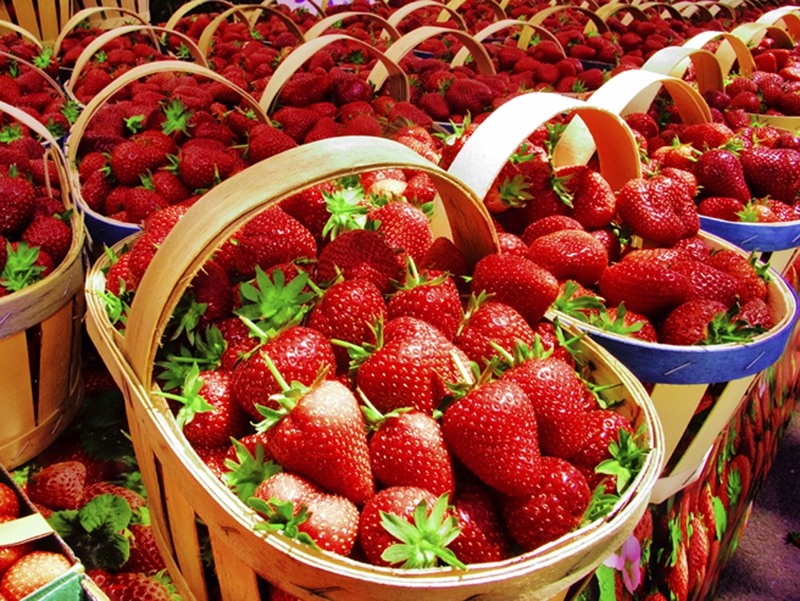Farm-to-Table
The Farm-to-Table Movement
Back in the early 1990's, when I was working with Seeds of Change and its pioneering ('Bioneering') publishing efforts to popularize biodiversity and organic/heirloom importance of seed saving/co-evolution and connection to fresh, healthy and tasty food production, I'd use a phrase that captured what was, to me, the key to a 'Chez Panisse-style', green alternative to 'Big Ag'.
Conventional agriculture with its industrial-size production methods, over-use of water and aquifer depletion, soil loss over time, and behind-the-scenes petrochemical fertilizer regime with pesticides/herbicides/miticides/fungicides and varied health-threatening inputs was at issue with our green, sustainability values and policies.
We chose to challenge the prevailing conventional agriculture/conventional large-scale food production-distribution chain and standard restaurant/conventional home kitchen model -- and over the past 20 years much has changed at every level in the US food industry. Much has changed for the better.
In the early- and mid-90s the phrase I felt was ripe to use as we produced our books and tours, conferences and events, and spread a better way, better foods message, was "peak of the season". So I'm adding it again here at GreenPolicy360 in 2015. The idea of fresh food, good food and sustainable, healthy production remains important today in the US -- and worldwide. Peak of the season is a message for the times, being in tune and being in touch with what is best for biodiversity, good food and wellness. The notion of "peak of the season" is a choice, choosing what is best when you have a choice to make about what you're eating...
In a peak-of-the-season way, we would consciously choose to eat in a 'farm-to-table' way, selecting what is healthy and, if possible, what is best seasonally from the local producers.
In agri-production at the local level, choices should include seed-saving, choosing what are the best seeds (allowing the healthiest, most undamaged-by-insects, flourishing varieties of crops to 'go to seed' and saving these seeds)... Over generations this 'co-evolution' selection has carried forward adaptation and next generation healthy/best tasting varietals... The wisdom of generations of producers, improving their farming with what we now call heirloom seeds, is there in the fields today and the next time you choose a particularly tasty variety of apple (almost inevitably not a hybrid, industrially produced variety), you are supporting farm-to-table. You are enabling growers to sustain "farm-to-table" that flourishes and you are improving the quality of your life and your community's well-being.
When you go to the next step and choose organic and 'natural' products at your local store, or farmers market, or in your family choices for a healthy diet, the wellness benefits are real. When you choose seasonal produce, locally grown, you are often choosing peak of the season...
The exceptional retail stores, and franchises who see that 'naturally produced' and 'fresh ingredients' is a trend to follow for market success, are offering choices today. The best way to go is for you (not your grocery store's buyer) to choose what's best for you and your family. Traditional grocery chains and all food retailers with forward-looking plans are responding to market pressure for quality, healthy, and special, seasonal food opportunities. Be choosy and 'think seasonal' to help this trend along.
Here's an example of my appreciation of peak of the season. Our Florida Strawberry festival season --- Next up, the Blueberry season!
'Nuff said.
Your Siterunner
○ ○ ○ ○ ○ ○ ○ ○ ○ ○ ○ ○
Farm-to-Table/Resources
- Feb 2015 - LA Times / Op-Ed / The food movement has only just begun
The mission for everyone who cares about food — even if you raise chickens or garden tomatoes, can barrel-aged hot sauce, or brew pale ale — should be to buy local. And then buy some more, regularly, every week, month and year. With enough momentum and time, consumer demand may bring on the substantial infrastructure and policy changes that small family farms need to truly thrive...
Just the other day, I heard from the organic farmer that he'd pulled together enough money from his city relatives to make his February payment and fend off foreclosure. Why? Because farming good food has never been as valued in the greater culture as it is today, and it motivated them to preserve their family's tradition of working the land.
Herein lies the promise. But it's much too soon to declare farm-to-table “been there, done that.” Far from being cliche, the food movement — at least for the people who labor so we can all eat better — has only just begun.
○
Farm-to-Table, Using Tech to Improve Distribution - Shortcut From Farm to Table Wall St Journal
Among the new entrants is Farmigo Inc., a San Francisco company that has 50,000 subscribers after launching late last year. Founded by Microsoft Corp. and SAP AG veteran Benzi Ronen, Farmigo allows consumers to search for and buy produce and meat from local farms that deliver to pick-up locations in their neighborhood, including offices like Yelp Inc., Twitter Inc. and Google.
○
Real Time Farms - http://www.realtimefarms.com/
"Know Where Your Food Comes From"
A crowd-sourced nationwide food guide. Trace your food back to the farm it came from, whether staying in or dining out, so you can find food you feel good about eating.
○
The Top Ten Farm-to-Table Restaurants - via Epicurious
Support Your Local Farm-to-Table Business... across the US Farm-to-Table Restaurant Locator from TripAdvisor
○
Tags: "Peak of the Season", Alternative Agriculture; Community Supported Agriculture; Market Gardening; Local Food Production; Sustainable; 'Slow Food'; 'Farm-to-Table' Restaurants; Sustainability; Food Nutrition and Wellness
